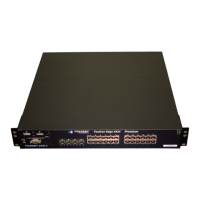Configuring Basic Software Features
December 2005 © Foundry Networks, Inc. 3 - 17
FESX424 Switch(config)# interface ve v1
FESX424 Switch(config-vif-1)# disable
Syntax: disable
To re-enable a virtual interface, enter the enable command at the Interface configuration level. For example, to re-
enable virtual interface v1, enter the following command:
FESX424 Switch(config-vif-1)# enable
Syntax: enable
Disabling or Re-Enabling Flow Control
You can configure full-duplex ports on a system to operate with or without flow control (802.3x). Flow control is
enabled by default.
To disable flow control on full-duplex ports on a system, enter the following:
FESX424 Switch(config)# no flow-control
To turn the feature back on:
FESX424 Switch(config)# flow-control
Syntax: [no] flow-control
Changing the Gigabit Fiber Negotiation Mode
The globally configured Gigabit negotiation mode is the default mode for all Gigabit fiber ports. You can override
the globally configured default and set individual ports to the following:
• Negotiate-full-auto – The port first tries to perform a handshake with the other port to exchange capability
information. If the other port does not respond to the handshake attempt, the port uses the manually
configured configuration information (or the defaults if an administrator has not set the information). This is
the default.
• Auto-Gigabit – The port tries to perform a handshake with the other port to exchange capability information.
• Negotiation-off – The port does not try to perform a handshake. Instead, the port uses configuration
information manually configured by an administrator.
To change the mode for individual ports, enter commands such as the following:
FESX424 Switch(config)# int ethernet 1 to 4
FESX424 Switch(config-mif-1-4)# gig-default auto-gig
This command overrides the global setting and sets the negotiation mode to auto-Gigabit for ports 1 – 4.
Syntax: gig-default neg-full-auto | auto-gig | neg-off
Modifying Port Priority (QoS)
You can give preference to the inbound traffic on specific ports by changing the Quality of Service (QoS) level on
those ports. For information and procedures, see the chapter “Configuring Quality of Service” on page 13-1.
Enabling Dynamic Configuration of Voice over IP (VoIP) Phones
You can configure a FastIron device to automatically detect and re-configure a VoIP phone when it is physically
moved from one port to another within the same device. To do so, you must configure a voice VLAN ID on the
port to which the VoIP phone is connected. The software stores the voice VLAN ID in the port’s database for
retrieval by the VoIP phone.
The dynamic configuration of a VoIP phone works in conjunction with the VoiP phone’s discovery process. Upon
installation, and sometimes periodically, a VoIP phone will query the Foundry device for VoIP information and will
advertise information about itself, such as, device ID, port ID, and platform. When the Foundry device receives the

